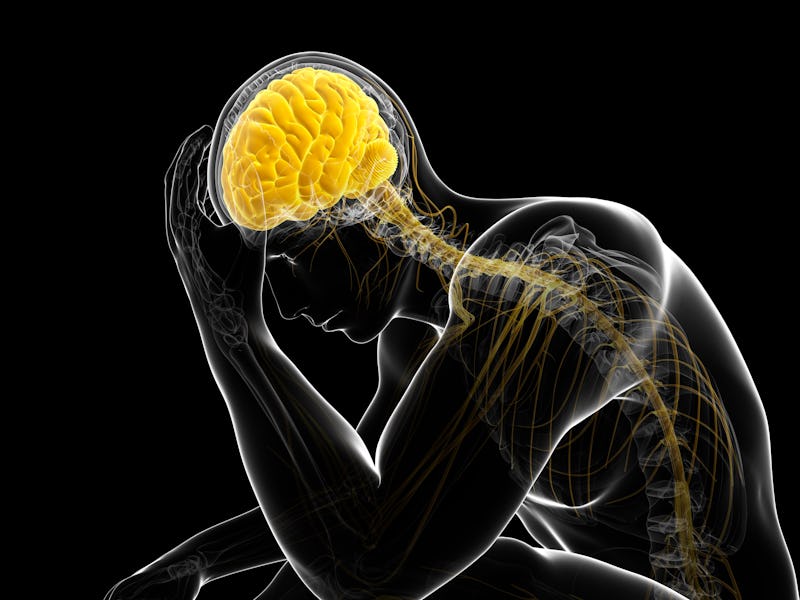Loneliness and hunger light up brain activity in similar ways
"The need to connect might be a basic human need."

When we miss a loved one or spend an extended period deprived of human contact, what manifests can seem like physical pain — a gnawing pit in our gut or ache in our chest.
But are social interactions truly a core human need, or is this feeling just a figment of our imaginations?
In a new study, researchers find empirical evidence of the former. Humans crave social contact in the same way they crave food, evidence suggests. Meanwhile, hunger and loneliness activate brain activity in similar, profound ways.
"In our brains’ 'motivation center' hunger and loneliness look very similar," study co-author Livia Tomova tells Inverse. Tomova is a cognitive neuroscientist Massachusetts Institute of Technology. Her team's findings were published Monday in the journal Nature Neuroscience.
"This suggests that the need to connect might be a basic human need."
These findings take on particular salience in a socially distant world. We may feel more disconnected than ever amid lockdowns that exacerbate an already troubling pattern of pervasive loneliness.
It's crucial for people to "pay attention to how much social contact they have," Tomova says, and "be aware that loneliness and isolation are affecting their brains."
Hungry and alone — To determine how social isolation and fasting influence the brain, Tomova's team rounded up a group of 40 healthy, socially connected young adults between 18 and 40 years old. Each participant completed two separate 10-hour sessions: In the first, people were totally isolated from in-person and online social interactions. No phones, social media, or face to face contact.
In the second condition, each participant underwent a fast. The group could have water, but no food or caloric drinks for 10 hours.
After each session, participants viewed images of social interactions, food, or flowers while their brains were scanned using a functional magnetic resonance imaging (fMRI) machine. The group also self-reported their experiences of loneliness, food craving, and social craving.
What they discovered — Unsurprisingly, people's cravings spiked in response to their deprivation. After fasting, people were hungry for food.
After isolation, people felt lonely and craved social interaction. This was the case even though isolation lasted a relatively short time and participants knew exactly when it would end.
Tomova and her team suggest that — for people who are highly socially connected — a day of social isolation is a large deviation from typical rates of social interaction.
"Loneliness acts as a signal – just like hunger."
"Although when chosen intentionally, solitude can be restful and rejuvenating, the externally mandated isolation was subjectively aversive," the team wrote.
When researchers analyzed the fMRI scans, they discovered that a midbrain region called the substantia nigra and ventral tegmental area (SN/VTA) showed greater responses to social images after isolation and to food images after fasting. This brain area is associated with reward and novelty responses consistent with dopamine-related brain activity.
Previously, this phenomenon had only been seen directly in animals.
This study extends the idea of "social homeostasis" from the animal models to humans, Tomova says.
"It provides empirical support for the idea that loneliness acts as a signal – just like hunger – that signals to an individual that something is lacking and that it needs to take action to repair that," she adds.
However, it's crucial to note that just because people may be alone, doesn't make them lonely.
"Loneliness is a subjective state and it is characterized by the experience of not having the amount of social connection one needs," Tomova says.
Curing the "loneliness epidemic" — Next, the team is interested in exploring how much, and what kinds of, positive social interaction is sufficient to fulfill humans' social needs and in turn, eliminate the neural craving response. This question is increasingly pressing in our collective present moment.
"The current lockdown highlights an issue that has actually been problematic for several years now – the numbers of people who feel lonely are increasing in modern societies around the world," Tomova says.
Some people place the blame on the rise of social media and digital technology. Others argue social media activity can make people feel more connected, not less.
More research is needed to determine the cause — and cure — for the so-called "loneliness epidemic." For people who are feeling lonesome, scientists suggest offering support to others who might be struggling, expressing gratitude to those around you, meditating, and trying therapy.
Psychologists remind us loneliness is a normal, common feeling. Like all emotions, it's temporary.
Abstract: When people are forced to be isolated from each other, do they crave social interactions? To address this question, we used functional magnetic resonance imaging to measure neural responses evoked by food and social cues after participants (n = 40) experienced 10 h of mandated fasting or total social isolation. After isolation, people felt lonely and craved social interaction. Midbrain regions showed selective activation to food cues after fasting and to social cues after isolation; these responses were correlated with self-reported craving. By contrast, striatal and cortical regions differentiated between craving food and craving social interaction. Across deprivation sessions, we found that deprivation narrows and focuses the brain’s motivational responses to the deprived target. Our results support the intuitive idea that acute isolation causes social craving, similar to the way fasting causes hunger.
This article was originally published on